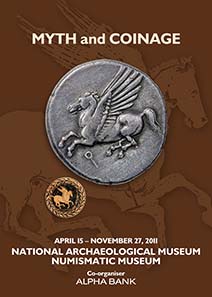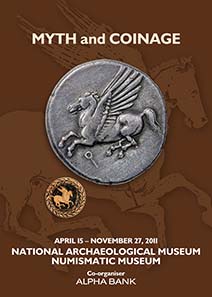5. Mai 2011 – For the first time, the National Archaeological Museum, the Numismatic Museum and the Alpha Bank Numismatic Collection collaborate and co-organise the temporary exhibition entitled “Myth and Coinage”, which will be presented concurrently in both Museums from April 15 to November 27, 2011.
The exhibition offers the possibility of a dialogue between Greek Mythology and ancient coinage and focuses on the illustration and use of myth on the faces of coins since the 7th century BC onwards.
The segment of the exhibition under the title “The Illustration of the Myth” will be presented at the National Archaeological Museum while that under the title “The Use of the Myth”, at the Numismatic Museum.
The general supervision and co-ordination of the exhibition is held by the directors of the two Museums, Dr Nikolaos Kaltsas (NAM) and Dr Despoina Evgenidou (NM) and the curator of the Alpha Bank Numismatic Collection Dr Dimitra Tsangari.
The architectural and exhibition design at the National Archaeological Museum is conducted by Mr Stamatis Zannos, while the museographical study and applications at the Numismatic Museum are the work of the architect Velissarios Voutsas.
The exhibition is accompanied by a fully-illustrated catalogue, with introductory texts and entries on all the exhibit items, both in Greek and English versions.
National Archaeological Museum: The Illustration of the Myth
In the exhibition unveiled at the National Archaeological Museum 261 coins from the Alpha Bank Numismatic Collection – which numbers more than 10,000 items and is considered one of the richest and most significant in the world – are showcased for the first time, alongside 71 coins from the Numismatic Museum and 79 selected artefacts from the National Archaeological Museum collections: sculptures, vases and metalwork. The exhibition has been divided in five sections with the purpose of promoting and highlighting the mythological themes depicted on the faces of coins throughout antiquity.
Sections
The first section, “The Dodecatheon”, is dedicated to the Olympian deities. The heads of the gods and goddesses as well as their attributes (e.g. owl, thunderbolt, etc.) adorn the obverse or the reverse of coins issued by ancient cities and kingdoms. The colossal marble head of Zeus from Aigeira in Achaia or the bronze statuette of the father of the gods brandishing the thunderbolt are exhibited beside bronze coins of Elis or Messene that bear the same iconographic theme.
The second section, “Mythical creatures”, includes representations of creatures like the Griffin, the Sphinx, the Chimaera or Medusa, which were significant emblems for the issuing authority. These daemons, which stood in-between gods and humans, were thought of as “guardians of mortals” and as such were depicted on coins often replacing the deity itself. Hence, a bronze figure of a Centaur is on display next to a coin of Demetrias in Magnesia (Centaurs resided on Mt Pelion).
The third section, “The demigod Heracles”, is dedicated to the greatest hero of Greek Mythology. Heracles and his labours adorn the issues of many cities. For example, Heracles and the Nemean lion are depicted on a black-figure krater and a silver coin of Nemea.
The fourth section, “The secondary deities”, includes those figures not as powerful as the Olympian gods but who nonetheless had a significant role in the lives of humans, like Asclepius (in Epidaurus) or Helios (in Rhodes).
The final fifth section, “Heroes and mythical stories”, includes depictions of heroes and mythical stories, primarily from the Iliad but also from mythological sagas, associated with local coinages. Opting to depict Homeric or local heroes served the need of the rulers to promote themselves and to attain a heroic ancestry or the moral dimensions of their selected hero (e.g. Pyrrhus, king of Epirus).
Events
Throughout the duration of the exhibition, educational programs will be organized by Nikoleta Xydea, archaeologist at the Museum, entitled “When a coin shall roll, a myth shall unfold” and intended for third, fourth – and fifth – grade pupils and for first – and second – year high school pupils.
The programs will be offered free of charge and by prior telephone appointment which can be scheduled by calling at 0030 210 821 7724 (Contact days and hours: Monday – Friday, 8:30 -16:30).
Numismatic Museum: The Use of the Myth
The exhibition aims at promoting and interpreting the representations of myths as these are depicted on coins and, thus, shed a light at their particular aspects. Coins, being objects in direct connection with the issuing authority constitute a convenient means of using and projecting myths in the context of expressing the official ideology. Mythological figures and scenes associated with the issuing authority are often represented on the faces of coins.
Nature, deified rivers, nymphs, symbolisms of natural phenomena as well as the goods of earth connected with or guarded by certain deities have been depicted on coins as a reference to the sources of wealth, local cults and traditions of each region.
The need of a city to prosper and survive long is reflected in the fact that it alludes its foundation to some mythical figure of divine ancestry, as this is indicated by their foundation myths and the portrayal of their mythical founders on their coins. The cities regularly place their activities and well-being under the protection of a divinity, which being the patron deity is displayed on coinage. The representation of local myths is related to the aspiration of the cities to define themselves, create their own identities and emphasize on their distinctiveness.
The prestige and power attributed by the divine presence on coins was also exploited by the rulers, who initially depicted the divine forefather of their dynasty and, later, their own images bearing the attributes of the ancestral gods. Dominant examples of this sort comprise the Macedonian kings and the Hellenistic monarchs.
The revival of mythological iconographic themes in Europe and Greece in modern times is approached through the presentation of coins and medals that bear scenes from mythology in order to promote an illustrious past or to describe current events wrapped in the aura of myth.
135)coins, 22 medals and 15 banknotes from the Numismatic Museum collections will be on display. Moreover, on temporary loan, 15 ancient Greek coins from the Alpha Bank Numismatic Collection, 13 artefacts from the National Archaeological Museum collections, 2 paintings from the National Gallery and one painting from the Bank of Greece collection will also be presented.
Dimitra Tsangari





